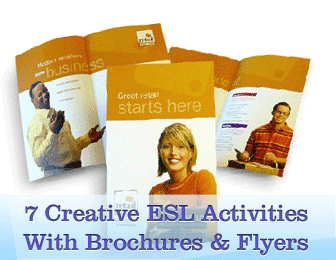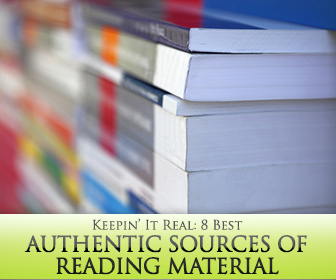What You Can Do with Brochures and Flyers: 7 Creative ESL Activities


Reading is an essential skill, and the coursebook certainly offers plenty of dialogues and texts to read – but the problem is they are written specifically for ESL learners. The conversations often sound stilted and contrived. The reading passages are simply not “real” enough.
When you think of authentic reading materials, you probably automatically think of books, newspapers and magazines, which are fine and dandy for advanced learners, but too difficult for beginners to tackle. The good news is there are plenty of authentic texts ESL students can read – at any level. And here are just a few suggestions:

Restaurant takeout menus offer a wealth of authentic food-related vocabulary, and not just the food items themselves, but the ways in which they are prepared (sautéed, fried, baked, etc.)
Suggested Reading Activity: After making sure that any new food-related vocabulary has been properly introduced, divide the class into pairs or small groups. Tell them that they are going to order some takeout, but first they have to decide what they are going to eat. Hand out role cards to make it more challenging:
Folks who place classified ads have to pay per line, which makes abbreviations absolutely necessary. But some are quite cryptic. With the use of classified ads you can give students a reading task that is challenging but not too difficult.
Suggested Reading Activity: First, go over a list of abbreviations; don’t tell them what each one means – have them guess. Include several like: a/c, furn., bdrm., kit., bath., lg., sm., etc… Then, give each student a real ad that they must decipher: 1 BR apt. in downtown Manhattan, near subway, lg. kit, central a/c, 2000/mo. They must answer questions about the property in question: How many bedrooms/bathrooms does it have? What are its main features?
Company websites provide opportunities to read about and discuss services and what people/companies do.
Suggested Reading Activity: Hand out role cards that include specific information your students have to look for: Go to (a moving company’s website) and find out if a) they offer services to your area; b) if they can take care of the packing, and c) if they can move pianos.
Put your students to the test, and see if they can find the item they’re looking for, with the characteristics they seek.
Suggested Reading Activity: Give your students print catalogs or direct them to an e-commerce site like eBay. Hand out cards that specify what they have to look for: You want a medium-sized, v-neck sweater in navy blue; you’re allowed to spend up to 30 dollars.
With an assortment of travel brochures, you can not only practice reading comprehension, but also grammar like conditionals: Where would you go if…
Suggested Reading Activity: Have students sit in a circle on the floor and place a variety of travel brochures in the center. Students pick up and read the brochures. When they find a place that interests them, they must each say: a) what place they picked for a vacation; b) why they picked it; and c) which features of the location/hotel/attraction mentioned in the brochure they like best.
Professional CVs/resumes give students the chance to practice reading skills and vocabulary they’ll need for job hunting.
Suggested Reading Activity: Print out several different CVs. There are plenty of websites that have great samples for a wide range of careers. Divide the class into pairs; one student will be the job applicant, and the other will conduct the job interview. The student conducting the interview will have to read the CV/resume and ask the applicant questions about his/her background.
Students will need to carefully read the showtimes to decide which show/movie to see and when. www.google.com/movies is a great resource and shows listings for your area, as well as information about each film.
Suggested Reading Activity: Hand out copies of newspaper clippings that show what’s playing that week. In pairs, students must read them and decide what movie they’ll see and when.
You’d think that the best texts for reading tasks are the magazine articles themselves, but they’re often too long and filled with vocabulary students find hard to grasp. Read the ads instead!
Suggested Reading Activity: Choose an ad from a magazine; make sure it has plenty of text, describes features/advantages, etc…Students read the ad and discuss the product’s characteristics. A great alternative is to give students different role cards:
Give the class a pile of magazine ads to look through; they must read them and find a product they would love to have. And be ready to tell the class why.
Authentic reading is not just about reading long newspaper articles or blog posts. Students must also learn to apply the reading skills that will get them what they need. The beauty about these real reading sources is that you’ll have the chance to give even real beginners, real texts to read.
Share it below!